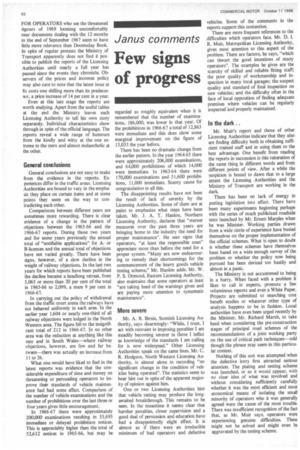Janus comments
Page 64

If you've noticed an error in this article please click here to report it so we can fix it.
Few signs of progress
regarded as roughly equivalent when it is remembered that the number of examinations, 186,000, was lower in that year. Of the prohibitions in 1966-67 a total of 12,863 were immediate and this does show some marginal improvement on the figure of 13,033 the year before.
There has been no dramatic change from the earlier pattern. In the year 1964-65 there were approximately 206,000 examinations, and 64,000 prohibitions of which 14,000 were immediate. In 1963-64 there were 170,000 examinations and 51,600 prohibitions, 11,000 immediate. Scanty cause for congratulation in all this.
The disappointing results have not been the result of lack of severity by the Licensing Authorities. Some of them are at pains to emphasize what steps have been taken. Mr. J. A. T. Hanlon, Northern Licensing Authority, declares that "sterner measures over the past three years are bringing home to the industry the need for proper maintenance". He sees signs that operators, "at least the responsible ones" appreciate more than before the need for a proper system. "Many are now endeavouring to remedy their shortcomings for the commencement of the heavy goods vehicle testing scheme," Mr. Hanlon adds. Mr. W. P. S. Ormond, Eastern Licensing Authority, also maintains that some operators at least "are taking heed of the warnings given and are paying more attention to systematic maintenance".
More severe Mr. A. B. Birnie, Scottish Licensing Authority, says disarmingly: "While, I trust, I act with restraint in imposing penalties I am steadily becoming severer in those I inflict as knowledge of the standards I am calling for is now widespead." Other Licensing Authorities speak on the same lines. Mr. C. R. Hodgson, North Western Licensing Authority, is almost alone in recording "no significant change in the condition of vehicles being operated". The statistics seem to bear him out in spite of the apparent majority of opinion against him.
One or two Licensing Authorities hint that vehicle testing may produce the longawaited breakthrough. This remains to be seen. In the meantime it seems clear that harsher penalties, closer supervision and a good deal of persuasion and education have had a disappointedly slight effect. It is almost as if there were an irreducible minimum of bad operators and defective vehicles. Some of the comments in the reports support this contention.
There are more frequent references to the difficulties which operators face. Mr. D. I. R. Muir, Metropolitan Licensing Authority, gives most attention to this aspect of the problem. There are factors, he says, "which can thwart the good intentions of many operators". The examples he gives are the scarcity of skilled and reliable fitting staff; the poor quality of workmanship and inspection in many local garages; the suspect quality and standard of final inspection on new vehicles; and the difficulty often in the face of local opposition of finding adequate premises where vehicles can be regularly inspected and properly maintained.
In the dark ..
Mr. Muir's report and those of other Licensing Authorities indicate that they also are finding difficulty both in obtaining sufficient trained staff and in using them to the best advantage. One benefit from reading the reports in succession is this reiteration of the same thing in different words and from different points of view. After a while the suspicion is bound to dawn that to a large Went the Licensing Authorities and the Ministry of Transport are working in the dark.
There has been no lack of energy in putting legislation into effect. There have been many experiments beginning perhaps with the series of much publicized roadside tests launched by Mr. Ernest Marples when he was Minister. Working parties drawn from a wide circle of experience have busied themselves on the proper implementation of the official schemes. What is open to doubt is whether these schemes have themselves been based on a wide enough survey of the problem or whether the policy now being pursued has been devised too hastily and almost in a panic.
The Ministry is not accustomed to being in a hurry. When faced with a problem it likes to call in experts, promote a few voluminous reports and even a White Paper. Projects are submitted to searching cost benefit studies or whatever other type of analysis happens to be in fashion. Local authorities have even been urged recently by the Minister, Mr. Richard Marsh, to take heed when considering the pre-construction stages of principal road schemes of the recommendations of a joint working party on the use of critical path techniques—odd though the phrase may seem in this particular context.
Nothing of this sort was attempted when the defective lorry first attracted serious attention. The plating and testing scheme was launched, or so it would appear, with no clear idea of what was involved and without considering sufficiently carefully whether it was the most efficient and most economical means of isolating the small minority Of operators who it was generally agreed were the cause of the most trouble. There was insufficient recognition of the fact that, as Mr. Muir says, operators were experiencing genuine difficulties. These might not be solved and might even lx aggravated by the testing scheme.












































































































